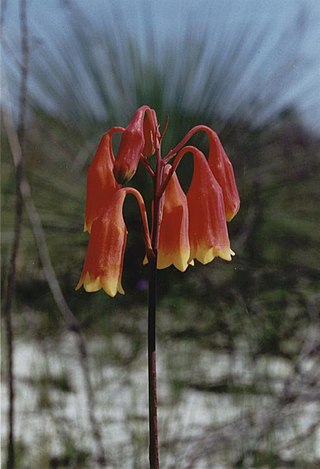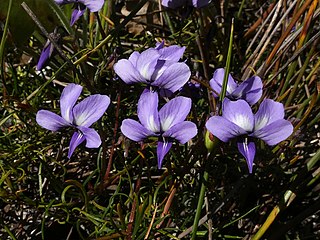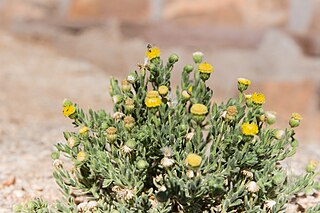
Blandfordia grandiflora, commonly known as Christmas bells, is a flowering plant endemic to eastern Australia. It is a tufted perennial herb with narrow, channelled, linear leaves and between two and twenty large, drooping, bell-shaped flowers. The flowers are red with yellow tips, or sometimes entirely yellow. It is one of four species of Blandfordia known as Christmas bells, this one growing on the coast and nearby ranges between Sydney in New South Wales and Fraser Island in Queensland.

Pterocaulon sphacelatum, commonly known as apple bush or fruit-salad plant, is a species of flowering plant in the family Asteraceae. It is an upright shrub with mostly pink to purple flowers and is endemic to Australia.

Darwinia grandiflora is a flowering plant in the family Myrtaceae. It is a dense, mat forming, prostrate shrub with clusters of tubular red flowers and is endemic to New South Wales.

Olearia asterotricha, commonly known as rough daisy-bush, is a species of flowering plant in the family Asteraceae. A tall shrub with white, mauve or blue daisy like flowers growing from the Blue Mountains in New South Wales to western Victoria, Australia.

Suaeda aegyptiaca is a species of succulent plant in the family Amaranthaceae, and salt-tolerant (halophyte) plant that is distributed in eastern North Africa, the Near East and West Asia.

Viola decumbens is a perennial plant with a woody base that is assigned to the violet family. It has linear leaves and stipules. The bilaterally symmetrical purple flowers have five petals and a spur. It grows in fynbos and is an endemic species of the southern Western Cape province of South Africa, where it is called wild violet, a name used for other species elsewhere in the world.

Cheiranthera linearis, commonly known as finger-flower, is a flowering plant in the family Pittosporaceae. It is a small shrub with deep purple flowers, yellow stamens and dull green linear shaped leaves. It is found growing in New South Wales, Victoria and Queensland.

Hibbertia linearis is a species of flowering plant in the family Dilleniaceae and is endemic to eastern Australia. It is a shrub with linear to oblong or egg-shaped leaves and yellow flowers with 15 to 25 stamens arranged around the three carpels.

Senecio malacitanus, also known as Senecio linifolius is a species of plant from South Africa.
Printzia pyrifolia is a species of plant from South Africa.

Nolletia gariepina, the desert beesbossie, is a species of plant from southern Africa.

Helichrysum retortum, the flask everlasting or sea strawflower, is a species of plant from South Africa.

Syncarpha speciosissima, the Cape everlasting or Cape sewejaartjie, is a species of plant from South Africa.
Osteospermum burttianum is a species of plant from South Africa.
Schistostephium griseum is a species of plant from southern Africa.
Thesium goetzeanum is a species of plant from Africa, where it grows between South Africa and Kenya.
Thesium lacinulatum is a species of plant from South Africa and Namibia.
Nemesia glaucescens is a species of plant endemic to South Africa. It belongs to the figwort family.

Nemesia linearis, also known as the witleeubekkie in Afrikaans, is a species of plant from southern Africa. It is found in South Africa and Namibia.
Manulea schaeferi is a species of plant from southern Africa. It grows in southern Namibia and the north-western parts of South Africa.












